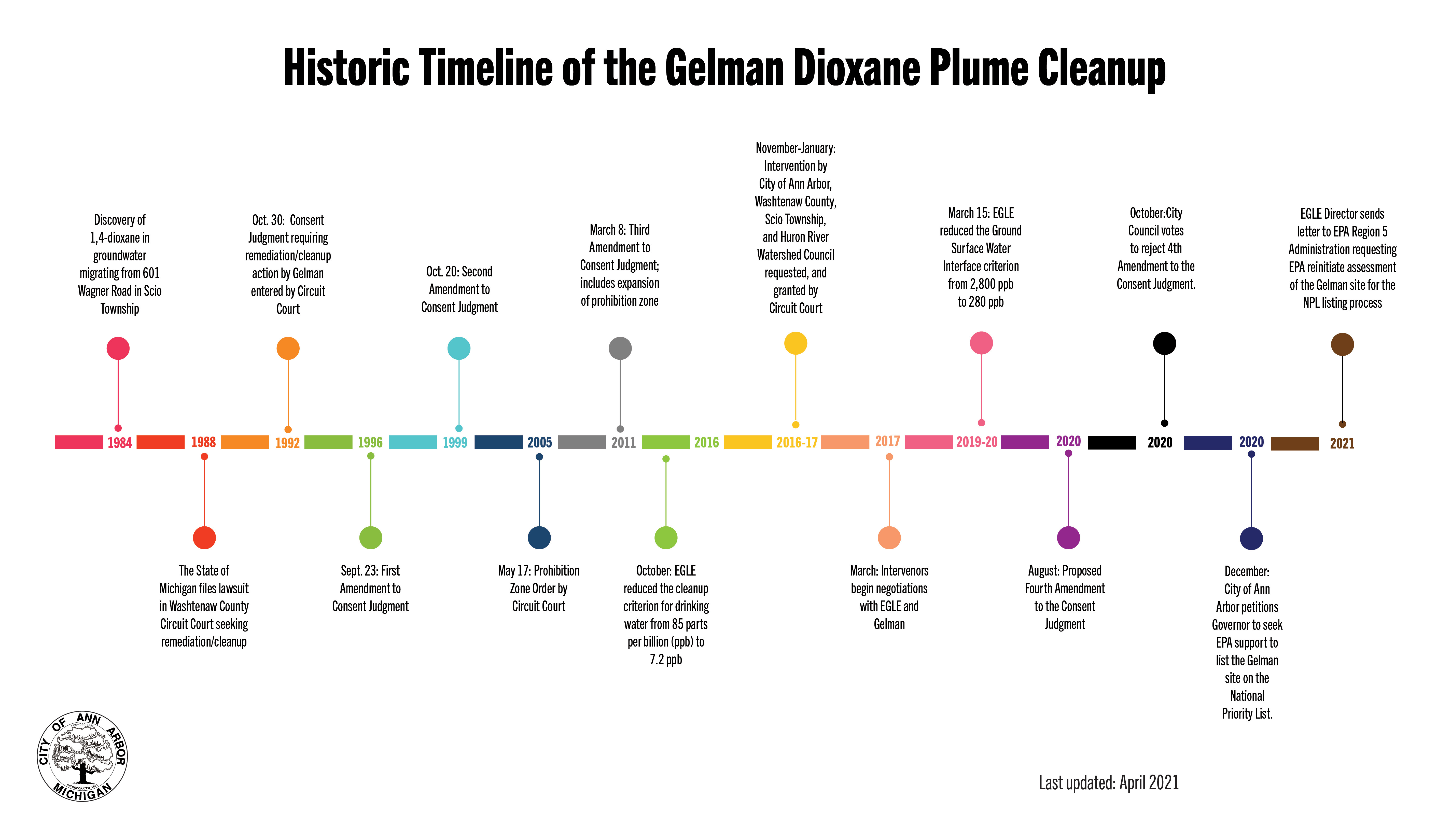Current Status
Quick Links
Brief Documents

Frequently Asked Questions (FAQs)
1. Who is currently in charge of the cleanup?
The Michigan Department of Environment, Great Lakes, and Energy (EGLE).
2. What is 1,4-dioxane (“dioxane") and what are the potential health impacts that might result from exposure to it?
Dioxane is a manmade compound that mixes easily in water. It is used in industry as a solvent to manufacture other chemicals and it is a by-product in many items, including paint strippers, dyes, greases, antifreeze and aircraft deicing fluids. It also is found in other chemicals that are used to manufacture cosmetics, detergents, deodorants and shampoos.
The International Agency for Research on Cancer has determined that 1,4-dioxane is 'possibly carcinogenic' to humans because it is a known carcinogen in animals. USEPA states that it is likely to be carcinogenic to humans. More information on exposure to 1,4-dioxane and its health effects is available via a
State of Michigan Department of Health and Human Services Fact Sheet (PDF).
3. Where is the dioxane in the groundwater and how did it get there?
Dioxane was used from the mid-1960s to the mid-1980s in the manufacturing processes at Gelman's facility on Wagner Road. Gelman's wastewater, containing dioxane, was disposed onsite during that time. In the mid-1980s dioxane was discovered offsite, in nearby surface waters and groundwater.
The groundwater in underground aquifers that is carrying dioxane is referred to as a plume. Multiple plumes have been spreading west in Scio Township and northeast then east into Ann Arbor, moving towards the Huron River. More information on dioxane and its location in the groundwater is located via a Washtenaw County Public Health Department Fact Sheet (PDF).
4. When was the original Consent Judgment established and what does it now require?
In 1992, the Washtenaw County Circuit Court entered a Consent Judgment regarding Gelman's dioxane contamination. Three amendments to the original Consent Judgment have been approved by the Court and are in effect.
The Consent Judgment and its amendments dictate the obligations of Gelman to investigate, clean up, contain and monitor the contaminated groundwater, under the direction of EGLE.
The Court did not require full cleanup of all of the released dioxane. As one example, the portion of the plume within the City of Ann Arbor and its projected pathway toward the Huron River, including buffer areas, is designated as the “Prohibition Zone." Because of existing and projected groundwater contamination within this zone, no uses of groundwater, such as residential wells for irrigation or other purposes, are permitted within this zone.
5. What is the Prohibition Zone (or “PZ") and how does it affect my property?
In the State vs. Gelman lawsuit, the Court approved a Prohibition Zone (“PZ") as an Institutional Control. This allows dioxane above the groundwater cleanup criterion to migrate, rather than be cleaned up, within the PZ. The “prohibition" part of the PZ title refers to a prohibition against installing or maintaining wells for drinking water or irrigation purposes on land within the PZ boundaries. All of the PZ is within the boundaries of the City of Ann Arbor, which requires all properties—regardless of where they are relative to the PZ—to connect to the city's municipal water supply system rather than get water from wells on their properties. The location of the PZ can be viewed on the
map (PDF, 11.19 MB).
6. What is the current status of the cleanup effort?
7. Could the United States Environmental Protection Agency (EPA) take over the cleanup of the site?
EPA will typically not take over a site if it is being managed by a state agency, such as EGLE, and there is a polluter covering the clean-up costs. However, if the state governor requests that EPA take over the clean-up activities, then a three-year process would begin, during which EPA would determine whether it believes the site should be proposed for listing on the National Priorities List. Following this initial assessment, the EPA process to develop a cleanup plan for a newly listed site can take over a decade. EPA has stated that it does have emergency powers to demand immediate actions if there are actual unacceptable exposures to dioxane which EPA stated would be a threshold of 46 ppb in drinking water. In the case of the Gelman Plume, this threshold has not been exceeded so an emergency intervention would not be available for this site. Representatives of the EPA addressed these questions and more at a
community meeting on January 16, 2020. In December 2020, Ann Arbor City Council sent a letter to Governor Whitmer requesting that she petition the EPA to list the Gelman site on the National Priorities List under the Federal CERCLA program.
A Gelman Community Information Session was held virtually on March 18, 2021. The meeting was organized by Representative Debbie Dingell and Washtenaw County. At the meeting, representatives from the U.S. Environmental Protection Agency (EPA) and the Michigan Department of Environment, Great Lakes, and Energy (EGLE) answered questions from the community and local officials around the status of the Plume and potential next steps.
On April 12, 2021 EGLE Director Liesl Clark sent a
letter (PDF) to Cheryl Newton, Action Regional Administrator for the USEPA Region 5 requesting that EPA reinitiate assessment of the Gelman site for the NPL listing process.
8. Where can I find more information about the use of phytoremediation for sites with 1,4-dioxane?
Technical information about projects where phytoremediation has been used on sites with 1,4-dioxane are available online. Less technical but still informative information is available on the website of the phytoremediation contractor Gelman will be using at http://treemediation.com. In particular, the Sarasota, FL case study under “Projects & Results” describes the use of phytoremediation on a site with 1,4-dioxane, including photographs and diagrams of the project.
